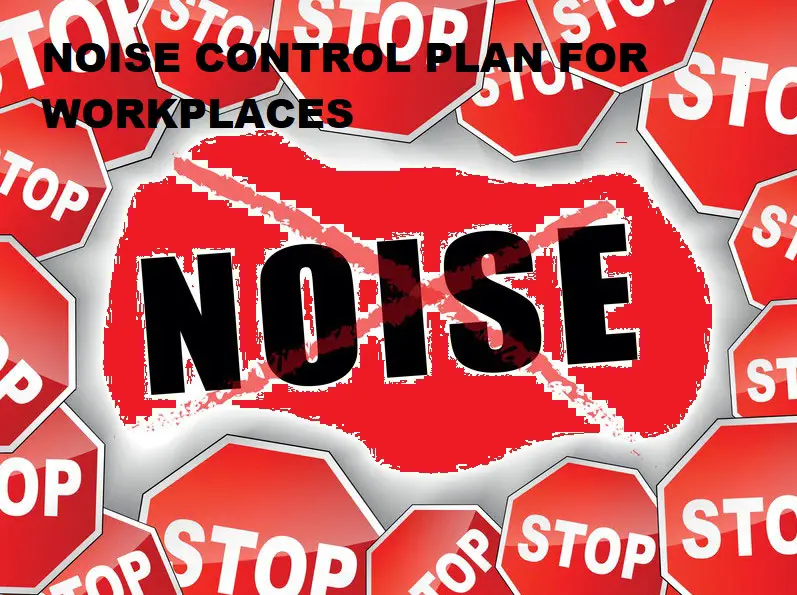Noise Control Plan sample

Noise Control Plan sample outlines the requirements of the Write your company name here Hearing Conservation Program and describes guidelines for implementing mitigation measures to limit noise levels and control nuisance noise that could affect sensitive receptors (i.e., adjacent businesses or contractors) during construction.
Noise control plan sample
The primary objective of the hearing conservation program is to prevent noise-induced hearing loss. This objective shall be accomplished by complying with the write the laws applicable in your country
- The identification of noise hazard areas, and the sampling and monitoring of noise exposure measurements.
- The reduction of noise exposures to safe levels with hearing protectors and/or engineering control procedures.
- The measurement of exposed employees hearing thresholds to monitor the effectiveness of the program.
- The education and motivation of employees and management regarding the need for hearing conservation, and the instruction of employees in the use and care of personal hearing protectors.
- The maintenance of accurate and reliable records of hearing and noise exposure measurements.
- The referral of employees, who have abnormal hearing thresholds, for examination and diagnosis.
2.0 DEFINITIONS
- dB(A) – Sound level (in decibels, referenced to 20- micro-Pascal) as measured using the A-weighting network on a sound-level meter, in accordance with ANSI S1.4 (American National Standards Institute) standards.
- L10 – The sound level exceeded 10 percent of the time for a specific monitoring period.
- Lmax – The maximum measured sound level at any instant in time.
- Nuisance Noise – Sound levels and/or vibration that annoys or disturbs a reasonable person of normal sensitivities, but that do not exceed guidelines for construction noise limits.
- Sensitive Receptors – Receptors that are particularly sensitive to nuisance levels of noise and vibration. Potential sensitive receptors are facilities/ business adjacent to project site and internal plant facilities.
- Slow – A time constant or 1 second for the root-mean-square (RMS) detector used by a sound level meter, in accordance with ANSI S1.4 standards.
3.0 Noise control plan
3.1 IDENTIFICATION OF NOISE HAZARDOUS AREAS
Noise hazard areas having continuous noise characteristics shall be identified by means of sound level measurements using a sound level meter. Measurements shall be recorded in decibels (dB). All areas identified as exceeding 90dB shall be identified as noise hazardous and warning signs shall be posted at the entrance of all hazardous noise areas. Signs should be placed at eye level and constructed of durable material. Signs shall clearly communicate the requirement for hearing protection in English and Arabic.
Areas that have been identified as exceeding 115dB, shall be identified with signs requiring the use of double hearing protection (a combination of earplugs and earmuffs). Disposable foam earplugs with a noise reduction rating of at least 30dB shall be available to employees and placed in a dispenser at the entrance to the hazardous noise area. Dispensers that will be located outside and subjected to heavy weather conditions should be constructed of clear acrylic and equipped with a self-closing lid.
3.2 NOISE EXPOSURE ASSESSMENTS Noise Control Plan
Noise dosimeters/ sound-level meters shall be used to evaluate exposures to employees who routinely work in high noise areas. Full work shift samples will be obtained on individual workers with dosimeters placed in the 90dB threshold mode. Employees who exceed, or may potentially exceed, an average of 85dB averaged over an 8-hour work shift, shall be included in the company’s Hearing Conservation Program. Permissible noise exposures are contained in Table 1 below.
3.3 REDUCTION OF NOISE EXPOSURE LEVELS
As soon as a noise hazard area has been determined, hearing protection devices shall be provided to reduce the exposures to safe levels.
Engineering control measures shall be applied, when feasible, to reduce the exposures to safe levels.
The following precautions shall be adhered to in order to ensure excessive noise is minimized:
a) Silenced equipment shall be used wherever practical,
b) Baffles shall be erected for excessively loud equipment,
c) Regular maintenance of equipment shall be carried out; lubrication, replacement of worn parts, etc.
3.4 HEARING MEASUREMENTS AND RECORD-KEEPING
Periodic hearing threshold measurements are necessary to monitor the effectiveness of personal hearing protectors. High-level noise exposures away from work may be partially responsible for any significant threshold shift (STS). It is therefore important to make a significant effort to determine the cause of these shifts. As a minimum, audiometric examinations shall be conducted at the start of employment and each year thereafter for employees who have been identified as being at risk for a hearing loss.
If an STS is found in an annual audiogram, a letter will be sent to the employee informing him or her of the results of the audiogram. When possible, individual consultation with the employee will be made to determine methods of reducing individual noise exposures.
All audiometric testing shall be in accordance with a recognized standard e.g. OSHA Regulation 29 CFR 1910.95. All records of audiometric testing and noise level readings shall be retained for a minimum of five years following the employee’s last day of employment with WRITE YOUR COMPANY NAME HERE Contracting.
3.5 TRAINING Noise Control Plan
Each employee and supervisor of employees, who are in the hearing conservation program, shall be trained annually.
As a minimum, the training program shall contain the following elements:
a) The effects of noise on hearing.
b) The purpose of hearing protectors, including the advantages, disadvantages, and attenuation of various types.
3.6 RESPONSIBILITY
SAFETY MANAGEMENT PERSONNEL SHALL:
- Determine the location and extent of hazardous noise areas and identify specific employees who must be entered into the hearing conservation program.
- Assure that complete and comprehensive records are maintained by corporate management for all audiograms, dosimeter results, and noise level measurements.
- Assure that each employee who has been included in the hearing conservation program is trained annually.
SUPERVISORS SHALL:
- Ensure that employees wear hearing protective devices whenever they enter a hazardous noise area.
- Post signs on equipment and in areas that are identified as producing hazardous noise.
- Provide hearing protective devices and assure that containers for hearing protectors are fully stocked.
EMPLOYEES SHALL:
- Participate in annual hearing conservation training.
- Wear Company provided hearing protection in areas where their use is required.
- Participate in the Company’s hearing conservation and audiometric testing program.
Table 1: PERMISSIBLE NOISE EXPOSURES of NOISE CONTROL PLAN
Duration Per Day Sound-Pressure Level
(Expressed in Hours) (Expressed in Decibels, dB)
8 90
6 92
4 95
3 97
2 100
1-½ 102
1 105
½ 110
1 Min 115
Note: When personnel are subjected to sound-pressure levels exceeding the limits shown above, personal hearing protection shall be used in accordance with the hearing conservation plan.
Noise Control Plan
4.1 INTRODUCTION Noise Control Plan
The tolerance of construction noise will vary by location as a function of construction activity, proximity to sensitive receptors, and line-of-site between construction and receptors. Mitigation measures shall be tailored to match location-specific conditions.
The maximum allowable project noise limits are presented in Table 2 below.
| Position | Noise Level dB(A) [World Bank Allowable Limits] | |
| Daytime | Nighttime | |
| Plant Fence | 70 | 70 |
| Nearest Sensitive Receptor | 55 | 45 |
Table 2: Project Related Noise Limits
Industry guidelines for Lmax values for construction noise emission limits for various types of equipment are presented in Table 3 below. Values represent a measurement at 15m from the construction equipment, with a slow (1 sec.) time constant. These values shall be used to identify locations for noise monitoring and the type of mitigation measures needed for noise abatement.
| EQUIPMENT | NOISE [dB(A)] | EQUIPMENT | NOISE [dB(A)] | |
| Auger Drill Rig | 85 | Generator (<25 kVA) | 70 | |
| Backhoe | 80 | Generator (>25 kVA) | 82 | |
| Compactor (ground) | 80 | Grader | 85 | |
| Concrete Pump | 82 | Hydra Break Ram | 90 | |
| Concrete Saw | 90 | Hoe Ram | 90 | |
| Concrete Truck | 85 | Jackhammer | 85 | |
| Crane | 85 | Paver | 85 | |
| Dozer | 85 | Pneumatic Tools | 85 | |
| Dump Truck | 84 | Pumps | 77 | |
| Excavator | 85 | Rock Drill | 85 | |
| Flat Bed Truck | 84 | Scraper | 85 | |
| Front End Loader | 80 | Vacuum Street Sweeper | 80 |
Table 3: Standard Lmax Noise Value Limits for Common Construction Equipment dB(A)
Noise levels shall be monitored and recorded during construction, as required. Data shall be recorded, filed, and maintained for future reference in the event of any complaints. Measurements shall be taken using a Type II meter, set on slow response and with an A-weighted scale, for 20 minutes. Measurements shall be taken with the instrument 1.5 meters above the ground and at least 1.5 meters from the nearest acoustically reflective surface. Data will be recorded, including Lmax and L10.
4.2 NOISE MITIGATION NOISE CONTROL PLAN
Construction-generated noise shall be managed and controlled to minimize increases above baseline levels, as indicated in Table 2 above, in order to protect workers and prevent nuisance noise conditions. Complaints concerning nuisance noise shall be responded to promptly and constructions methods assessed and adjusted to address valid concerns.
The noise mitigation methods shall be based on the relationship of construction activity to the location of sensitive receptors, site-specific conditions (e.g., Topography), assessment of construction activity, and required methods/ equipment.
- Accounting for noise sensitive receptors during the design phase, particularly in siting lay-down, parking and stockpile areas, and siting noise generating areas away from sensitive receptors, if possible.
- Scheduling work to minimise duration and limit night time and early morning impacts.
- Conducting toolbox talks emphasising potential impacts to adjacent sensitive receptors, as well as proper equipment maintenance to minimise excessive noise.
- Orientate construction equipment to block the line-of-sight, to help limit direct noise impact on receptors.
- Ensuring proper silencers/ mufflers are installed, equipment maintenance is being performed, and that modifications are not performed that will increase the noise emitted.
- Ensuring vehicles are equipped with horns or other signalling devises that are sufficiently loud to serve as a danger warning device, but do not produce unnecessarily loud noise.
- Minimising blasting, or reducing and staggering blast charges.
- Obeying speed limits. These limits shall be strictly enforced in all locations that have project traffic.
- Limiting time windows for blasting operations and high-pressure releases, and providing a minimum 24-hour notice to potentially affected sensitive receptors (e.g., communities).
USEFUL LINKS






